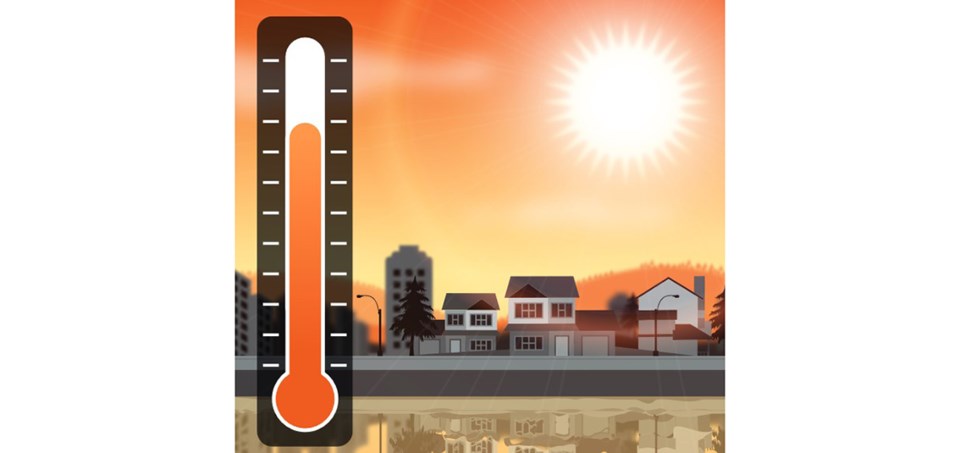Environment and Climate Change Canada has issued heat warnings for the Prince George and Stuart-Nechako areas, as well as recent warnings for the Cariboo-North including Quesnel.
Daytime high temperatures in the 30’s combined with overnight lows in the mid-teens are expected through at least Wednesday of this week, and in some cases the end of the week. More details on the alerts are available here.
The Province has not declared an extreme heat emergency for these regions.
Conditions mean there's a higher risk of heat-related illness.
If you have air conditioning at home, make sure it is in good working order.
If you don't have air conditioning:
- Find somewhere you can cool off on hot days. Consider places in your community to spend time indoors such as libraries, community centres, movie theatres or malls. Also, as temperatures may be hotter inside than outside, consider outdoor spaces with lots of shade and running water.
- Close windows, curtains and blinds during the heat of the day to block the sun and prevent hotter outdoor air from coming inside. Open doors and windows when it is cooler outside to move that cooler air indoors.
- Ensure that you have a working fan, but do not rely on fans as your primary means of cooling. Fans can be used to draw cooler late-evening, overnight and early-morning air indoors.
- Keep track of temperatures in your home using a thermostat or thermometer. Sustained indoor temperatures over 31 C can be dangerous for people who are susceptible to heat.
- If your home gets very hot, consider staying with a friend or relative who has air conditioning if possible.
- Identify people who may be at high risk for heat-related illness. If possible, help them prepare for heat and plan to check in on them.
Everyone is at risk of heat-related illness, Environment Canada advises, but hot temperatures can be especially dangerous for:
- Older adults
- People who live alone
- People with mental illnesses such as schizophrenia, depression or anxiety
- People with pre-existing health conditions such as diabetes, heart disease or respiratory disease
- People with substance use disorders
- People with limited mobility and other disabilities
- People who are marginally housed
- People who work in hot environments
- People who are pregnant
- Infants and young children
To protect your health:
- Drink plenty of water and other liquids to stay hydrated, even if you are not thirsty.
- Spray your body with water, wear a damp shirt, take a cool shower or bath or sit with part of your body in water to cool down.
- Take it easy, especially during the hottest hours of the day.
- When outside, stay in the shade and use a broad-spectrum sunscreen with SPF 30 or higher.
- Take immediate action to cool down if you are overheating. Signs of overheating include feeling unwell, headache and dizziness. Overheating can lead to heat exhaustion and heat stroke.
- Signs of heat exhaustion include heavy sweating, severe headache, muscle cramps, extreme thirst and dark urine. If you are experiencing these symptoms, you should seek a cooler environment, drink plenty of water, rest, use water to cool your body and monitor your symptoms.
- Signs of heat stroke include loss of consciousness, disorientation, confusion, severe nausea or vomiting and very dark urine or no urine. Heat stroke is a medical emergency.
In the event of a medical emergency, call 911. However, it is important to use 911 responsibly to avoid overwhelming the system.
When to call 911:
- In cases of heat stroke: loss of consciousness, disorientation, confusion, severe nausea or vomiting or very dark urine or no urine.
- In general: when there is chest pain, difficulty breathing, loss of consciousness, severe burns, choking, convulsions that are not stopping, a drowning, a severe allergic reaction, a head injury, signs of a stroke, signs of an overdose or a major trauma.
If you have a less urgent health issue:
- You can call HealthLinkBC at 811 and speak with a nurse or go to an urgent care centre or clinic if you can do so safely. That way, our emergency medical dispatch staff and paramedics will be available for people who need their services the most.
- There are also online tools at healthlinkbc.ca, including a “Check Your Symptoms” tool.
About the BC Heat Alert and Response System (BC HARS)
The BC HARS includes two levels of alerts: heat warning and extreme heat emergency.
Heat warning:
- Two or more consecutive days in which daytime maximum temperatures are expected to reach or exceed regional temperature thresholds and night-time minimum temperatures are expected to be above regional temperature thresholds.
- After the first three events of the summer in a given forecast region, the BC HEAT Coordinating Committee (BC HEAT) may recommend extending the minimum number of days for Heat Warning criteria in that region by a day
- A moderate increase in public health risk.
Extreme heat emergency:
- Heat warning criteria have been met and daytime maximum temperatures are expected to substantively increase day over day for three or more consecutive days.
- A very high increase in public health risk.
More information on extreme heat and heat warnings can be found at https://www.northernhealth.ca/health-topics/extreme-heat-and-heat-warnings


.png;w=120;h=118;mode=crop)
